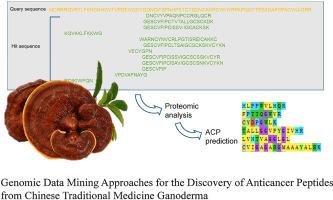当前位置:
X-MOL 学术
›
Phytochemistry
›
论文详情
Our official English website, www.x-mol.net, welcomes your feedback! (Note: you will need to create a separate account there.)
Genomic data mining approaches for the discovery of anticancer peptides from Ganoderma sinense
Phytochemistry ( IF 3.8 ) Pub Date : 2020-11-01 , DOI: 10.1016/j.phytochem.2020.112466 Sheng Zheng 1 , Ning Zhu 2 , Cheng Shi 2 , Heng Zheng 2
Phytochemistry ( IF 3.8 ) Pub Date : 2020-11-01 , DOI: 10.1016/j.phytochem.2020.112466 Sheng Zheng 1 , Ning Zhu 2 , Cheng Shi 2 , Heng Zheng 2
Affiliation

|
Drug discovery from traditional Chinese medicine (TCM) typically involves the extraction of active ingredients from natural products with high biological activity and function from the vast repertoire of traditional Chinese medicine. This strategy cannot fully exploit the vast resources of TCM. Known as the longevity mushroom, Ganoderma spp. has been used as medicine for thousands of years. Recent studies have demonstrated its anticancer activity. While most research on Ganoderma spp. has focused on their polysaccharides or small molecules as potential anticancer components, possible anticancer peptides (ACPs) or proteins have been neglected. In this study, genomic data mining approaches were used to discover potential ACPs from Ganoderma sinense. A search against known ACPs identified 477 proteins in the G. sinense proteome that possess putative ACP sequences and that thus may serve as parent proteins. After in silico digestion by trypsin, 34 G. sinense proteins were predicted to release putative ACPs (by the mACPpred program). A subsequent sequence similarity comparison against known ACPs identified 15 trypsin-digested fragments as possible ACPs, of which 3 sequences were identical to known ACPs. The results indicated that ACPs may be involved in the anticancer activity of G. sinense and that genomic mining approaches can be effective strategies for discovering active components in TCM resources. The accumulation of genomic and proteomic data will undoubtedly accelerate drug discovery from TCM resources.
中文翻译:

用于发现灵芝抗癌肽的基因组数据挖掘方法
从传统中药 (TCM) 中发现药物通常涉及从大量中药库中提取具有高生物活性和功能的天然产物的活性成分。这种策略不能充分利用中医药的巨大资源。被称为长寿蘑菇,灵芝属。几千年来一直被用作药物。最近的研究证明了它的抗癌活性。虽然大多数关于灵芝属的研究。已经将它们的多糖或小分子作为潜在的抗癌成分,而可能的抗癌肽 (ACP) 或蛋白质却被忽视了。在这项研究中,基因组数据挖掘方法被用来从灵芝中发现潜在的 ACP。对已知 ACP 的搜索在 G. 具有推定的 ACP 序列的正义蛋白质组,因此可以作为亲本蛋白质。在用胰蛋白酶进行计算机消化后,预计 34 种 G. sinense 蛋白质会释放推定的 ACP(通过 mACPpred 程序)。随后与已知 ACP 的序列相似性比较确定了 15 个胰蛋白酶消化的片段作为可能的 ACP,其中 3 个序列与已知 ACP 相同。结果表明,ACPs 可能参与了葛缕子的抗癌活性,基因组挖掘方法可以成为发现中药资源中活性成分的有效策略。基因组和蛋白质组学数据的积累无疑将加速中药资源的药物发现。正弦蛋白被预测会释放假定的 ACP(通过 mACPpred 程序)。随后与已知 ACP 的序列相似性比较确定了 15 个胰蛋白酶消化的片段作为可能的 ACP,其中 3 个序列与已知 ACP 相同。结果表明,ACPs 可能参与 G. sinense 的抗癌活性,基因组挖掘方法可以成为发现中药资源中活性成分的有效策略。基因组和蛋白质组学数据的积累无疑将加速中药资源的药物发现。sinense 蛋白预计会释放假定的 ACP(通过 mACPpred 程序)。随后与已知 ACP 的序列相似性比较确定了 15 个胰蛋白酶消化的片段作为可能的 ACP,其中 3 个序列与已知 ACP 相同。结果表明,ACPs 可能参与了葛缕子的抗癌活性,基因组挖掘方法可以成为发现中药资源中活性成分的有效策略。基因组和蛋白质组学数据的积累无疑将加速中药资源的药物发现。结果表明,ACPs 可能参与 G. sinense 的抗癌活性,基因组挖掘方法可以成为发现中药资源中活性成分的有效策略。基因组和蛋白质组学数据的积累无疑将加速中药资源的药物发现。结果表明,ACPs 可能参与了葛缕子的抗癌活性,基因组挖掘方法可以成为发现中药资源中活性成分的有效策略。基因组和蛋白质组学数据的积累无疑将加速中药资源的药物发现。
更新日期:2020-11-01
中文翻译:

用于发现灵芝抗癌肽的基因组数据挖掘方法
从传统中药 (TCM) 中发现药物通常涉及从大量中药库中提取具有高生物活性和功能的天然产物的活性成分。这种策略不能充分利用中医药的巨大资源。被称为长寿蘑菇,灵芝属。几千年来一直被用作药物。最近的研究证明了它的抗癌活性。虽然大多数关于灵芝属的研究。已经将它们的多糖或小分子作为潜在的抗癌成分,而可能的抗癌肽 (ACP) 或蛋白质却被忽视了。在这项研究中,基因组数据挖掘方法被用来从灵芝中发现潜在的 ACP。对已知 ACP 的搜索在 G. 具有推定的 ACP 序列的正义蛋白质组,因此可以作为亲本蛋白质。在用胰蛋白酶进行计算机消化后,预计 34 种 G. sinense 蛋白质会释放推定的 ACP(通过 mACPpred 程序)。随后与已知 ACP 的序列相似性比较确定了 15 个胰蛋白酶消化的片段作为可能的 ACP,其中 3 个序列与已知 ACP 相同。结果表明,ACPs 可能参与了葛缕子的抗癌活性,基因组挖掘方法可以成为发现中药资源中活性成分的有效策略。基因组和蛋白质组学数据的积累无疑将加速中药资源的药物发现。正弦蛋白被预测会释放假定的 ACP(通过 mACPpred 程序)。随后与已知 ACP 的序列相似性比较确定了 15 个胰蛋白酶消化的片段作为可能的 ACP,其中 3 个序列与已知 ACP 相同。结果表明,ACPs 可能参与 G. sinense 的抗癌活性,基因组挖掘方法可以成为发现中药资源中活性成分的有效策略。基因组和蛋白质组学数据的积累无疑将加速中药资源的药物发现。sinense 蛋白预计会释放假定的 ACP(通过 mACPpred 程序)。随后与已知 ACP 的序列相似性比较确定了 15 个胰蛋白酶消化的片段作为可能的 ACP,其中 3 个序列与已知 ACP 相同。结果表明,ACPs 可能参与了葛缕子的抗癌活性,基因组挖掘方法可以成为发现中药资源中活性成分的有效策略。基因组和蛋白质组学数据的积累无疑将加速中药资源的药物发现。结果表明,ACPs 可能参与 G. sinense 的抗癌活性,基因组挖掘方法可以成为发现中药资源中活性成分的有效策略。基因组和蛋白质组学数据的积累无疑将加速中药资源的药物发现。结果表明,ACPs 可能参与了葛缕子的抗癌活性,基因组挖掘方法可以成为发现中药资源中活性成分的有效策略。基因组和蛋白质组学数据的积累无疑将加速中药资源的药物发现。

























 京公网安备 11010802027423号
京公网安备 11010802027423号